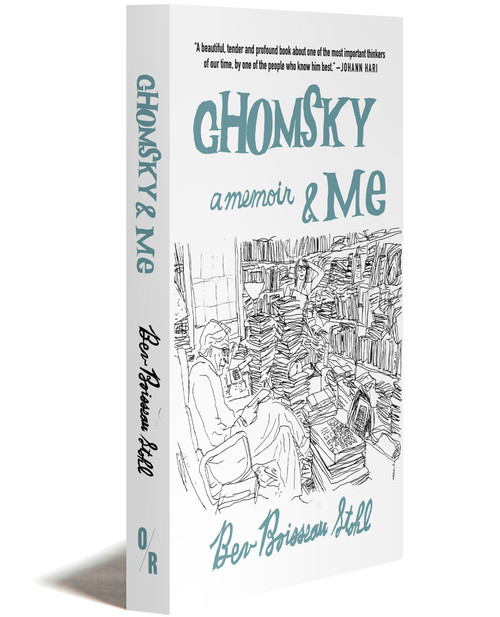Chomsky and Me
“This is a beautiful, tender and profound book about one of the most important thinkers of our time, by one of the people who know him best. A masterpiece of observation and memoir.”
— Johann Hari“Intimate … and so much fun.”
— Michel Gondry“An amazing story.”
— Catherine Keenerabout the bookabout
Bev Stohl ran the MIT office of the renowned linguist and social critic Noam Chomsky for nearly two and a half decades. This is her account of those years, working next to a man described by the New York Times as “arguably the most important intellectual alive today.”
Through these pages we observe the comings and goings of a constant and varied stream of visitors: the historian Howard Zinn; activists Alex Carey, Peggy Duff, and Dorie Ladner; the inventor of the World Wide Web, Tim Berners Lee; actors Catherine Keener and Wallace Shawn; the writer Norman Mailer; gaggles of fourteen-year-old school students, and the world’s leading linguists. All make appearances in these stories. Many who visit are as careless of their allotted time as Chomsky is generous with his. Shepherding them out in mid-conversation is one of Bev’s more challenging responsibilities.
Other duties include arranging lectures to overflow crowds around the world, keeping unscrupulous journalists at bay, preventing teetering ziggurats of paper and books from engulfing her boss, and switching on his printer when it is deemed “broken” by a mind that is engaged less by mundane technology than the realms of academia and activism.
Over the years, what has commenced as a formal working arrangement blossoms into something more: a warm and enduring friendship that involves work trips to Europe, visits with her partner and dog to Noam’s summer home on Cape Cod, and a mentorship that challenges Bev with all manner of intriguing mental and practical puzzles.
Published with the approval of its subject and written with affection, insight and a gentle sense of humor, Chomsky and Me describes a relationship between two quite different people who, through the happenstance of work, form a bond that is both surprising and reciprocally rich.
“A ringside seat on the life and times of a man regarded by millions as a remote intellectual deity, but who comes into sharp focus through the delightfully warm and humorous lens of Bev Stohl as a relatable mortal … If you want to know the real Noam Chomsky, this is the book for you.”
—Amir Amirani
About The Author / Editor
Preview
At work, I checked our morning schedule: a student discussing her linguistics research, a crew filming a documentary on the expanding carbon bubble, and a journalist writing about the US elections. I had a habit of holding my breath while concentrating, and I caught myself swaying with dizziness throughout the day, steadying myself with deep breaths. A half-hour before our last appointment, noted on our schedule as “Meeting with Sufi L. to discuss oppressed Sindh people, 30 minutes,” I looked up to see him, a middle-aged man with dark curly hair hanging his coat on our coat rack. Our office assistant, Glenn, ushered him back out to the hallway, where two mesh chairs near an emergency exit made up our waiting area.
When I asked him in, a young woman rose to join us, just as Noam created a logjam in the doorway, uttering a quick hello with a wave and a promise to return soon. To me he was Noam, but to most of the world he was Noam Chomsky, renowned linguist, US media and social critic, political activist, cognitive scientist, and author. Roxy, my cocker spaniel and our usual greeter, slept on her cozy bed under my desk during the commotion. At ten, she was beginning to lose her hearing.
Sufi L. introduced the woman, his student, by name, then introduced himself as “Sufi.” When I took his hand, or he took mine, something unexpected coursed through me. I felt a slow fall into a sense of peace, and for a moment it took some effort to keep my knees from buckling. He had gotten my attention.
Sufi’s eyes, like black almonds, drew me in, and I got it. He was indeed a Sufi, as in the practice of Sufism, which was, to my limited knowledge, a spiritual mysticism. Holding his hand, I felt serenity, nothingness. Nothingness except that he was clean-shaven. I would have expected a Sufi to have a beard. Everyone has told me to breathe more, beginning with the nurse who put me in an oxygen tent as a four-pound newborn. And it was the first thing Sufi—my Sufi (if only for this brief moment)—told me.
in the media
Chomsky and Me
“This is a beautiful, tender and profound book about one of the most important thinkers of our time, by one of the people who know him best. A masterpiece of observation and memoir.”
— Johann Hari“Intimate … and so much fun.”
— Michel Gondry“An amazing story.”
— Catherine Keenerabout the bookabout
Bev Stohl ran the MIT office of the renowned linguist and social critic Noam Chomsky for nearly two and a half decades. This is her account of those years, working next to a man described by the New York Times as “arguably the most important intellectual alive today.”
Through these pages we observe the comings and goings of a constant and varied stream of visitors: the historian Howard Zinn; activists Alex Carey, Peggy Duff, and Dorie Ladner; the inventor of the World Wide Web, Tim Berners Lee; actors Catherine Keener and Wallace Shawn; the writer Norman Mailer; gaggles of fourteen-year-old school students, and the world’s leading linguists. All make appearances in these stories. Many who visit are as careless of their allotted time as Chomsky is generous with his. Shepherding them out in mid-conversation is one of Bev’s more challenging responsibilities.
Other duties include arranging lectures to overflow crowds around the world, keeping unscrupulous journalists at bay, preventing teetering ziggurats of paper and books from engulfing her boss, and switching on his printer when it is deemed “broken” by a mind that is engaged less by mundane technology than the realms of academia and activism.
Over the years, what has commenced as a formal working arrangement blossoms into something more: a warm and enduring friendship that involves work trips to Europe, visits with her partner and dog to Noam’s summer home on Cape Cod, and a mentorship that challenges Bev with all manner of intriguing mental and practical puzzles.
Published with the approval of its subject and written with affection, insight and a gentle sense of humor, Chomsky and Me describes a relationship between two quite different people who, through the happenstance of work, form a bond that is both surprising and reciprocally rich.
“A ringside seat on the life and times of a man regarded by millions as a remote intellectual deity, but who comes into sharp focus through the delightfully warm and humorous lens of Bev Stohl as a relatable mortal … If you want to know the real Noam Chomsky, this is the book for you.”
—Amir Amirani
About The Author / Editor
Preview
At work, I checked our morning schedule: a student discussing her linguistics research, a crew filming a documentary on the expanding carbon bubble, and a journalist writing about the US elections. I had a habit of holding my breath while concentrating, and I caught myself swaying with dizziness throughout the day, steadying myself with deep breaths. A half-hour before our last appointment, noted on our schedule as “Meeting with Sufi L. to discuss oppressed Sindh people, 30 minutes,” I looked up to see him, a middle-aged man with dark curly hair hanging his coat on our coat rack. Our office assistant, Glenn, ushered him back out to the hallway, where two mesh chairs near an emergency exit made up our waiting area.
When I asked him in, a young woman rose to join us, just as Noam created a logjam in the doorway, uttering a quick hello with a wave and a promise to return soon. To me he was Noam, but to most of the world he was Noam Chomsky, renowned linguist, US media and social critic, political activist, cognitive scientist, and author. Roxy, my cocker spaniel and our usual greeter, slept on her cozy bed under my desk during the commotion. At ten, she was beginning to lose her hearing.
Sufi L. introduced the woman, his student, by name, then introduced himself as “Sufi.” When I took his hand, or he took mine, something unexpected coursed through me. I felt a slow fall into a sense of peace, and for a moment it took some effort to keep my knees from buckling. He had gotten my attention.
Sufi’s eyes, like black almonds, drew me in, and I got it. He was indeed a Sufi, as in the practice of Sufism, which was, to my limited knowledge, a spiritual mysticism. Holding his hand, I felt serenity, nothingness. Nothingness except that he was clean-shaven. I would have expected a Sufi to have a beard. Everyone has told me to breathe more, beginning with the nurse who put me in an oxygen tent as a four-pound newborn. And it was the first thing Sufi—my Sufi (if only for this brief moment)—told me.








